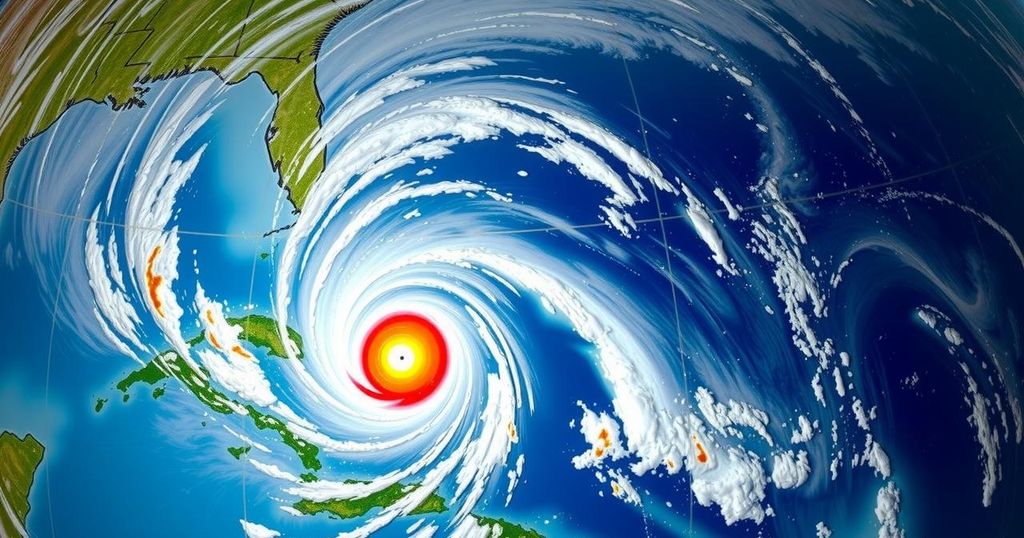Weather
World news
AFRICA, BRIAN MCNOLDY, CARRIACOU, CUBA, EVACUATIONS, GULF OF MEXICO, HURRICANE, HURRICANE SEASON, KATE, MCNOLDY, MILTON, NATIONAL HURRICANE CENTER, NATURAL DISASTER, NATURAL DISASTERS, NORTH AMERICA, OSCAR, SOUTH AFRICA, U. S, UNIVERSITY, UNIVERSITY OF MIAMI, VIRGINIA
Ethan Kim
0 Comments
2024 Atlantic Hurricane Season Ends With Record Storm Activity
The 2024 Atlantic hurricane season concluded with 11 hurricanes, exceeding the average of seven. Significant storms included Hurricane Beryl, which became the earliest Category 4 hurricane, and Hurricane Helene, which was the deadliest since Katrina in 2005. The season was largely influenced by higher ocean temperatures, with extensive damage reported across multiple states.
The conclusion of the 2024 Atlantic hurricane season on Saturday marked a season characterized by a noteworthy 11 hurricanes, significantly surpassing the average of seven. Meteorologists referred to it as a “crazy busy” season, attributing this activity to unusually high ocean temperatures, which facilitated the formation and intensification of hurricanes. Notably, eight hurricanes made landfall across various regions, including the U.S., Bermuda, Cuba, the Dominican Republic, and Grenada.
Among these, Hurricane Beryl distinguished itself as the first Category 4 hurricane to emerge in the month of June, impacting the island of Carriacou in Grenada and leading to the destruction of crops and infrastructure in Jamaica, resulting in two fatalities. According to Brian McNoldy, a hurricane research expert at the University of Miami, the recent intensity and timing of Beryl were unprecedented, as Category 5 hurricanes are rarely observed until September 1 according to the National Hurricane Center.
In September, Hurricane Helene produced catastrophic impacts across the southeastern United States, resulting in over 200 deaths, and was noted as the deadliest storm to strike the U.S. mainland since Hurricane Katrina in 2005. North Carolina reported at least $48.8 billion in damages as residences, water systems, and agricultural areas suffered extensive destruction.
Further intensification was observed in October when Hurricane Milton achieved maximum wind speeds of 180 mph, establishing it as one of the most robust hurricanes recorded in the Gulf of Mexico. The rainfall amounts in areas affected by Helene and Milton significantly surpassed normal levels for that time of year, leading to record precipitation in cities such as Asheville, Tampa, and Orlando.
In November, Hurricane Rafael approached the fierce threshold of 120 mph, positioning it as one of the strongest November hurricanes in the Gulf, comparable to Hurricane Kate from 1985. Rafael’s landfall in Cuba came at a challenging time as the island sought to recover from prior widespread power outages due to Hurricane Oscar in October.
McNoldy noted that while specific weather events cannot be solely attributed to climate change, there is a discernible influence that increases the likelihood of extreme storm events.
“In other words, we never had a storm as strong as Beryl so early in the season anywhere in the Atlantic and we never had a storm as strong as Milton so late in the season in the Gulf of Mexico,” he concluded.
The Atlantic hurricane season, typically recognized from June 1 to November 30, demands close attention due to its potential for severe weather events that can lead to significant loss of life and property. Each year, meteorologists analyze patterns and conditions contributing to hurricane formation, noting that unusual ocean temperatures can dramatically impact the strength and timing of these storms. The 2024 season has been particularly exceptional, showcasing unprecedented events that underscore the evolving patterns of severe weather in relation to climate change implications.
In summary, the 2024 Atlantic hurricane season was marked by an extraordinary number of impactful hurricanes, including notable events such as Hurricane Beryl and Hurricane Helene. The season’s activity reflected an alarming trend influenced by climatic factors, highlighting both the unpredictability of hurricane patterns and the substantial potential for devastation posed by these storms. As meteorologist Brian McNoldy indicates, ongoing changes in climate play a crucial role in shaping the intensity and timing of hurricanes, necessitating awareness and preparedness across vulnerable areas.
Original Source: nsjonline.com




Post Comment